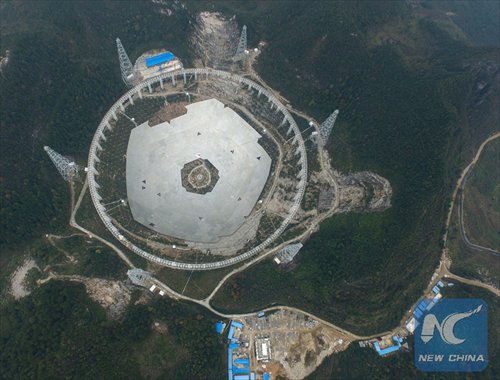
Photo taken on Dec. 16, 2015 shows aerial view of the construction site of the Five-hundred-meter Aperture Spherical Telescope in Southwest China's Guizhou Province. (Photo/Xinhua)
The relocation of thousands of people away from the site of the world's largest radio telescope in Southwest China's Guizhou Province is not due to health risks posed by the new facility, said a source in charge of the project.
Around 9,100 people from 2,029 families living within 5 kilometers of the radio telescope - which was built to look for alien life - will be relocated by the end of September, reported the Xinhua News Agency.
"The telescope will not send out electromagnetic waves and there will be no radiation, and it's wrong to say the relocation was caused by health concerns for nearby residents," a source in charge of the 500-meter Aperture Spherical Telescope, or FAST, told the Global Times on Thursday.
"Simply speaking, the relocations were not about forcing people away from the telescope, but are due to the telescope's need to 'hide from' electromagnetic interference produced by human and industrial civilization," the source added.
The authorities specifically choose a site for the telescope in an underdeveloped area with little electromagnetic interference, and its location in a valley surrounded by mountains will also cut down on electronic interference, he noted.
Residents of Pingtang county and Luodian county in Guizhou Province will be resettled in four settlements by the end of September, according to Li Yuecheng, secretary-general of the Chinese People's Political Consultative Conference Guizhou Provincial Committee, Xinhua reported.
Construction of the FAST project began in March 2011 and cost 1.2 billion yuan ($184 million). The telescope, whose dish is the size of more than 30 soccer fields, will be the world's largest of its kind, overtaking Puerto Rico's Arecibo Observatory, which is 300 meters in diameter.
Wu Xiangping, director-general of the Chinese Astronomical Society, previously told Xinhua that Chinese scientists have worked on "secondhand" data collected by others for years and have failed to achieve a breakthrough.
He said a more sensitive telescope is needed to receive weaker and more distant radio messages.
Each of the relocated locals will receive a 12,000 yuan relocation subsidy from the provincial reservoir and eco-migration bureau, and each ethnic minority household with housing difficulties will get an extra 10,000 yuan subsidy from the provincial ethnic and religious committee.
Unlike optical telescopes, which use visible light - a type of electromagnetic radiation - to observe the universe, radio telescopes operate in the radio frequency portion of the electromagnetic spectrum, where they can detect and collect data on radio signals from outer space.


















































